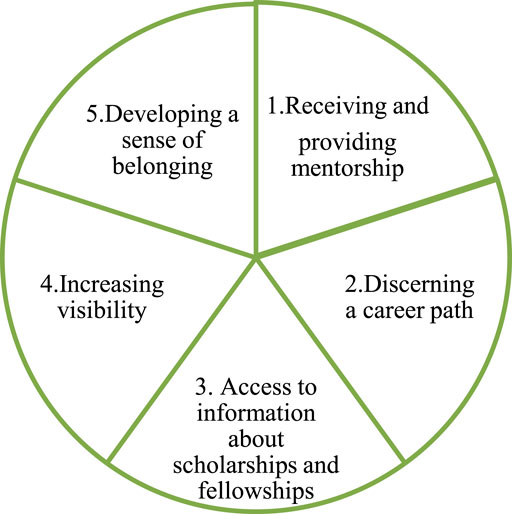Introduction
Central America serves as a compelling geographical setting for the exploration of women’s scientific communities and their participatory dynamics. Countries such as Guatemala, El Salvador, Honduras, and Nicaragua have been identified as scientifically disadvantaged (Wagner et al., 2001; IDB Inter-American Development Bank, 2010; TWAS, 2020). Alongside Costa Rica and Panamá, these nations exhibit a glaring deficit in research capacity when juxtaposed with globally recognized standards (Padilla-Perez and Gaudin, 2014). During a historical period where knowledge economies wield increasing influence, these societies grapple with the allocation of essential resources necessary for advancing science and technology capabilities.
Faced with urgent issues like severe poverty, systemic inequality, political turmoil, and limited access to fundamental services such as healthcare and education, these societies often push science and technology to the margins of their public agendas. In this framework, the participation of women in research and scientific endeavors frequently encounters structural barriers, which hinder their access to STEM career opportunities and greatly restrict their potential for community engagement and involvement.
Since 1993, the Organization for Women in Science for the Developing World (OWSD) has offered a platform for women scientists from developing countries, including those living abroad, to network and build communities (OWSD, 2020; Quadrio-Curzio et al., 2020). A pivotal aspect of this networking has been outreach to the scientific female diaspora, promoting exchanges and collaborations among women from various countries.
While regions such as Africa, the Middle East, and South Asia show significant progress with active National Chapters, Latin America, particularly Central America, has seen slower advancements. Despite 27 years of encouragement from OWSD, no national chapters were established in Central America until 2020. However, within a year, chapters were created in Guatemala and Honduras, with El Salvador and Panamá also engaging in the process. This indicates that delving into the experiences of women in scientific communities in Central America can yield valuable insights for other underrepresented scientific groups.
An OWSD National Chapter comprises a community of women scientists who hail from a specific developing country (including those overseas) focused on enhancing women’s involvement in science and technology, fostering scientific leadership, and promoting participation in scientific decision-making both nationally and regionally (OWSD, 2020). The establishment of a chapter necessitates a minimum of 20 members and a local host institution. Once formed, OWSD National Chapters engage in strategic activities based on the identified priorities of their countries, which can include outreach initiatives aimed at schools and the public (Quadrio-Curzio et al., 2020).
Community Building and Participation in Women Scientists’ Groups
For this study, community building and participation are understood as the various ways women in science engage with a shared sense of belonging linked to their research interests. These groups can be formally structured (e.g., scientific academies, associations, foundations, and NGOs) or informal (e.g., online platforms, collaborative groups, and discipline-focused networks). However, effective participation requires systematic engagement, as opposed to ephemeral group formations tied to specific events or social structures. Most scientific societies in Guatemala, El Salvador, Honduras, and Panamá are predominantly male-oriented (Calles-Minero, 2010; WEF, 2020), leading to a concentration of STEM-related research opportunities for men. Consequently, the social context often deems these fields inappropriate for women (IDB Inter-American Development Bank, 2010; Calles-Minero, 2013; Fernandez-Poluch et al., 2016).
The lack of specific policies and practices addressing gender inequalities in science, insufficient representation of women in decision-making roles, and a lack of initiatives to create networks among female scholars have resulted in decades of isolated experiences in women’s scientific community building.
This study’s researchers sought to investigate the underlying causes of these outcomes by examining barriers at individual, institutional, economic, and social levels through primary and secondary qualitative data collection and analysis. The findings illuminate the incentives and disincentives faced by women scientists in Central America as they navigate participation in science-related communities.
Science Diplomacy Perspective
Central American countries have relied on international support for decades to bolster their science and technology frameworks (Bonilla and Kwak, 2014; Bonilla and Kwak, 2015; Bonilla et al., 2019). Within this context, science diplomacy (SD) studies can provide a valuable framework for analyzing relevant science and technology issues covered in this research. SD encompasses practices that intersect science, innovation, technology, and foreign policy to address common international challenges (The Madrid Declaration on Science Diplomacy, 2019) while fostering international scientific collaborations.
Scientific networks emerge as crucial vehicles for sustainable development, social cohesion, and international relations (Fedoroff, 2009; Linkov et al., 2016; Balakrishnan, 2018; Mauduit and Gual-Soler, 2020). Balakrishnan (2018) articulates that SD can be effectively utilized in three dimensions: 1) providing scientific insights for foreign policy (science in diplomacy); 2) advocating for international scientific collaboration (diplomacy for science); and 3) leveraging scientific cooperation to enhance inter-country relations (science for diplomacy). The second dimension, which focuses on facilitating international scientific collaborations, is particularly relevant for this analysis, as it aims to harness global science and technology resources to fortify national capacities and lay the groundwork for joint partnerships (Melchor et al., 2020).
Emerging evidence underscores the significance of nurturing inclusive networks to address gender imbalances and enhance voices from women in scientific circles. Recent literature also emphasizes the crucial role of inclusivity and intentional strategies in fostering effective science diplomacy (Aukes et al., 2021; Moreno et al., 2017).
Conclusion
The pressing need for women’s representation in science necessitates focused efforts to cultivate scientific communities within Central America. The barriers faced by women scientists at multiple levels detract from their opportunities for career advancement and limit the collective potential for knowledge production in the region. By leveraging science diplomacy principles and fostering inclusive networking opportunities, the establishment of sustainable communities of women scientists can empower marginalized voices and pave the way for future generations of female scientists.


